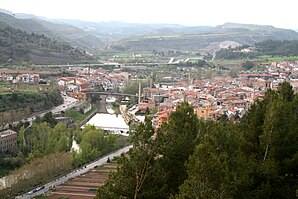Sallent de Llobregat
| Sallent municipality | ||
|---|---|---|
 Sallent - town view
|
||
| coat of arms | Map of Spain | |

|
|
|
| Basic data | ||
| Autonomous Community : |
|
|
| Province : | Barcelona | |
| Comarca : | Bages | |
| Coordinates | 41 ° 50 ′ N , 1 ° 54 ′ E | |
| Height : | 278 msnm | |
| Area : | 65.63 km² | |
| Residents : | 6,658 (Jan 1, 2019) | |
| Population density : | 101.45 inhabitants / km² | |
| Postal code : | 08650 | |
| Municipality number ( INE ): | 08191 | |
| administration | ||
| Website : | www.sallent.cat | |
Sallent is a place and a municipality ( municipi ) with 6658 inhabitants (as of January 1, 2019) in the comarca of Bages in the province of Barcelona in the autonomous region of Catalonia . The municipality also includes the localities of La Botjosa, Cabrianes, Cellers de la Serra, Cornet, Sant Martí i Fucimanya, Sant Ponç, Serraïma and Serra-sanç .
location
Sallent lies at an altitude of about 280 meters above sea level. d. M. on the east bank of the Riu Llobregat . The cities of Barcelona and Manresa are about 77 kilometers southeast and 17 kilometers southwest, respectively.
Population development
| year | 1960 | 1970 | 1981 | 1990 | 2000 | 2011 |
| Residents | 9.227 | 8,650 | 8,148 | 7,785 | 7.159 | 6,866 |
Already in the second half of the 19th century the community had about 4,500 inhabitants; Since then, the population has continued to grow until the 1960s, which was not interrupted by the mechanization of agriculture . Only in the last few decades did the population decrease significantly.
economy
In the past, the inhabitants lived mainly as a self-sufficient living from agriculture , which also included growing wine and keeping cattle. As early as the end of the Middle Ages , Sallent also functioned as a craft and mercantile center for the villages and individual farms in the area. In the early 19th century, the Pla de Bages region developed into an important wine-growing region , but as a result the communities suffered particularly from the phylloxera crisis . The local textile industry provided jobs until the middle of the 20th century; then production was relocated to low-wage countries . In the last few decades, small craft and industrial companies have settled here.
history
Already in Iberian times there was a village ( Poblat ibèric del Cogulló ) in the municipality , the foundation walls of which were exposed during excavations. So far, no finds have been made from the Roman , Visigothic or Islamic periods . In the 9th and 10th centuries the area was recaptured ( reconquista ), repopulated ( repoblación ) and secured with castles ( castells ) by the Counts of Barcelona . If you follow the city arms, there was already a bridge over the Riu Llobregat here in the Middle Ages; the current one dates from the 18th century. In the final phase of the War of the Spanish Succession , i. H. In 1713, Spanish soldiers destroyed the powder mills in the place .
Attractions
At first glance, the town of Sallent, which is not very attractive, has an abundance of listed buildings, the majority of which, however, are town houses from the 19th and early 20th centuries.
- The ruins of the Iberian settlement ( Poblat ibèric del Cogulló ) are more interesting for specialists, but the view over the valley is worthwhile.
- The ruins of the castle ( castell ) are located on a hill above the village.
- Immediately next to it is the Romanesque round church of Sant Esteve i Sant Sebastià , which was restored at the end of the 20th century, with its three apses , which - as the only architectural ornament - end with arched friezes below the eaves . It is probably the former castle chapel , but one could also think of a church of the Knights Templar - in any case it is an almost unique building for Catalonia - with the exception of the much smaller church of Vilanova near Santa Maria d'Oló .
- In several villages belonging to the community there are still Romanesque parish or hermit churches ( ermitas ), which are particularly impressive because of their secluded location.
literature
- Vicenç Buron: Esglésies Romàniques Catalanes. Artestudi Edicions, Barcelona 1977, p. 88, ISBN 84-85180-06-2 .
Web links
- Sallent, sights - photos + info (catalan)
- Sallent, Poblat ibèric del Cogulló - Photos + Info (Catalan)
- Sallent, castle and round church - photo + info (Catalan)
- Press vats in the vineyards, history and functionality - photos + information (Wikipedia, Catalan)
Individual evidence
- ↑ Cifras oficiales de población resultantes de la revisión del Padrón municipal a 1 de enero . Population statistics from the Instituto Nacional de Estadística (population update).





